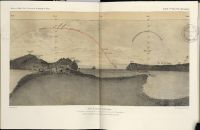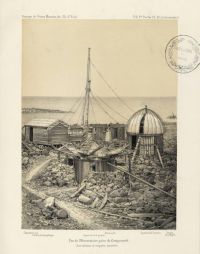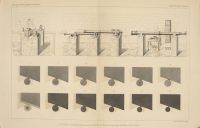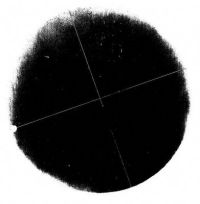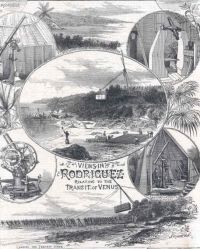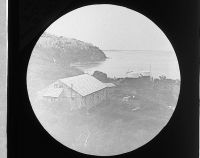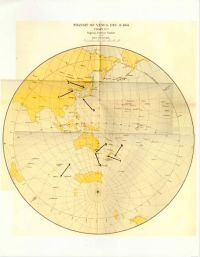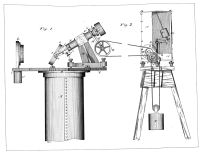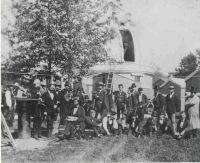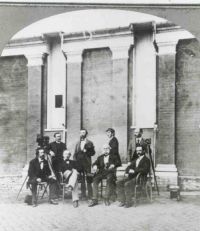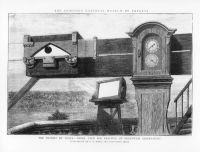|
Written on Venus's transit of 1874 Preparation of the transit observations of 1874French missions observations of 1874English missions observations of 1874 German missions observations of 1874 American missions observations of 1874 Other missions observations of 1874 The black drop effect and instrumental diffraction This transit is expected a lot because of the technology improvements that occurred since the 1769 transit (such as clocks, photography…) along with the improvement of astronomical tables. Preparation of the transit observations of 1874Proctor 1868, MNRAS-29 (1868) p.211-222 and p.306-317 [[ MNRAS-29 p.211-222 ]] and [[ MNRAS-29 p.306-317 ]] Richard Anthony Proctor (1837-1888), from Cambridge, extensively prepared the 1874 and 1882 transits. He presents here a stereographic projection of Earth (as seen from the Sun), with the visibility zones and the parallax effects. During the 1874 transit, Proctor considered that Halley’s method was better than the one of Delisle for the solar parallax determination. Proctor 1873, MNRAS-33 (1873) p.421-422b [[ MNRAS-33 p.421-422b ]] Proctor published an 1874 transit map in polar view (p. 422b). Proctor 1873, Studies of Venus transits [[ 20362 (001à091) ]]
[20362] Proctor, R. A., Studies of Venus transits. An investigation of the circumstances of the transits of Venus in 1874 and 1882, London, 1882. English text, (170 p). Faye 1872, CRhAS-74 (1872) p. 561-567 [[ CRhAS-74 p.561-567 ]] The apparition of photography lead to improvements in the Venus transit observations that might be compared to those that occurred around 1670 with the use of lens telescopes coupled to the measurement instruments, and gave birth to high precision astrometry. Janssen 1873, CRhAS-76 (1873) p. 677-679 [[ CRhAS-76 p.677-679 ]] Jules Janssen (1824-1907) proposed to take a series of pictures with a camera mounted on a rotating disc. Dumas 1874, CRhAS-78 (1874) p. 1796-1806 and 1813-1815 [[ CRhAS-78 p.1796-1806 ]], [[ CRhAS-78 p.1813-1815 ]] Six French missions are organized to Extreme-Orient (Beijing, Saigon, Yokohama), southern Indian Ocean (Saint-Paul Island), Noumea and Campbell Island. The composition of the missions is given p. 1802. Janssen 1874, CRhAS-79 (1874) p. 6-7 [[ CRhAS-79 p.6-7 ]] Jules Janssen (1824-1907) realized the device he imagined in 1873 (CRhAS-76, p. 677) [[ CRhAS-76 p.677-679 ]] and presents the different steps of a Venus transit simulation. This device is called the photographic "revolver". Harkness 1877, MNRAS-37 (1877) p. 93-95 [[ MNRAS-37 p.93-95 ]] The horizontal photoheliograph is composed of a heliostat mobile mirror that precisely reflects the solar light in the horizontal axis of a fixed lens telescope, towards a photographic plate. The heliostat orientation is driven by a clockwork movement that allows the astronomers to follow the apparent motion of the Sun. The lens telescope is oriented along the meridian. French missions observations of 1874Various authors, CRhAS-80 (1875) p. 32-1599 This volume encompasses numerous observations performed by the French missions during the 1874 transit. Instants are given in local mean time. The most noteworthy texts are : - Fleuriais in Beijing, Charles André (1842-1912) and Alfred Angot in Noumea, [[ CRhAS-80 p.32-34 ]] - Jules Janssen at Nagasaki. Nagasaki’s site (South-west of Japan) was preferred to the initial selected site Yokohama (suburb of Tokyo), 900 km from Nagasaki. In spite of the poor weather, the two contacts were observed without the presence of any ligament or drop. Numerous pictures were taken with the photographic "revolver". Janssen reported the observation of the Sun’s coronal atmosphere (p. 345) thanks to the Venus partial eclipse. [[ CRhAS-80 p. 34 ]], [[ CRhAS-80 p.342-345 ]] - Pietro Tacchini (1838-1905), in India, noticed 2 minutes discrepancies when the contacts are observed with the spectrograph of visually through the lens telescope. [[ CRhAS-80 p.36 ]] - Héraud in Saigon, [[ CRhAS-80 p.243-251]] - Ernest Mouchez (1821-1892) observed from Saint-Paul Island (39° S in the southern Indian Ocean), where the weather is frequently cloudy apart from the “new moon’s day” according to a local proverb. The Venus transit occurred that very day! Mouchez observed a halo around Venus, contrary to his collaborator Turquet. 489 photographic proofs were produced. [[ CRhAS-80 p.611-618 ]] - Jean-Jacques Bouquet de la Grye (1827-1909) observed at Campbell Island (500 km south of New Zealand) [[ CRhAS-80 p.721-725 ]] - Observations from Fleuriais in Beijing, [[ CRhAS-80 p.1203-1212 ]] - Observations from André in Noumea, [[ CRhAS-80 p.1281-1285 ]] - Victor Puiseux (1820-1883) calculated the solar parallax from observations performed in Noumea and Saint-Paul Island : 8.88". Charles André found 8.88" and then 8.82" (p. 1599) [[ CRhAS-80 p.933-935 ]] French missions 1874, Science Academy Report This long report (in 9 volumes) from the Science Academy is a selection of several reports describing the 1874 French missions. One can successively read : - volume 1, 2nd part : photographic operations,
- volume 3, 1st et 2nd parts : the mission in Campbell Island (Bouquet de la Grye), - volume 3, appendixes : calculation of the solar parallax. The value found is 8.80" +/- 0.06" corresponding to a precision smaller than 0.7 % (p. 76) [[ 1952-03-02-atlas-annexe-0082 ]] Institut de France, Académie des sciences. Recueil de mémoires, rapports et documents relatifs à l’observation du passage de Vénus devant le Soleil (Selection of reports and documents related to the observations of the Venus transit in front of the Sun ), Gauthiers-Villars, 1876-1890, 9 vol. (extracts). English missions observations of 1874Airy 1881, English missions [[ 1958-(0001à0584) ]] This long report of more than 500 pages contains all details about the observations from the 1874 English missions, supervised by the Royal Astronomer George Biddell Airy (1801-1892) : in the Sandwich Islands (= Hawaii Island) by George Tupman (at Oahu), by Flitner (at Waikiki), by Forbes (at Kailua), and by Johnson (at Waimea), in Egypt by Orde Browne (near the Cairo), and by Hunter (at Suez), at the Rodriguez Island, that became English in 1814 (by Neate, Wharton, Hoggan), in the Kerguelen Island (by Perry, Corbet, Goodridge, Sommerville) and in New Zealand at Burnham, 30 km from Christchurch (by Palmer). Nice schematics of the black drop phenomenon are shown (in particular p. 334bis at Suez), and the halo around Venus (in particular p. 462bis at Kerguelen Island). You may consult the table of contents at the beginning [[ 1958-0002 ]]. [1958] Airy, sir George Biddell, Account of observations of the transit of Venus, made under the authority of the British Government, and of the reduction of the observations, 1874, dec 8, 1881. Printed and illustrated English text, (584 p). Honolulu site in Hawaii [[ 1874-tupman-honolulu ]] The English mission installed in Honolulu (at the Sandwich island = Hawaii), under the direction of George Tupman, is well defended! At Luxor (Egypt), only the coming out of the transit was visible. Venus was moving (here) to the left. Various instruments of observation ; local manpower participated to their installation. Tennant 1877, Indian mission [[ 2451-(001à064) ]] Report from the English mission in India. J. F. Tennant (born in 1829) observed at Roorkee, 150 km North Delhi ; Strahan is at Lahore, 400 km N-W Delhi (in the current Pakistan). [2451] Tennant J. F., Report on the preparations for, and observations of the transit of Venus, as seen at Roorkee and Lahore, on December 8, 1874, Calcutta, 1877. English text (58 p). German missions observations of 1874German missions 1874, Venus Durchgänge [[ 3307 (0001à0118) ]] Reports on the observations conducted by Valentiner and Adolph at Tchefou (China), performed by the German missions in 1874 : Borgen and Weinek at Kerguelen Island (Betsy Bay), Schur and Seeliger at Auckland Island, Low and Pechüle at Mauritius Island, Becker and Fritsch at Ispahan (Iran). Map of the Auckland Island site [[ 0047 ]] that should be compared to the picture [[ m196800200013 ]] and the print [[mp002274 ]]. [3307] Venus Durchgänge (die) 1874 und 1882. Bericht über die deutschen Beobachtungen, im Auftrage der Commission für die Beobachtung des Venusdurchgangs, Berlin, 1889-1898, 6 vol. German text. German mission at Auckland Island, print [[ mp002274 ]] The Germans Adolph Schur (1846-1901) and Seeliger observed at the Auckland Island, located 500 km south New Zealand (51° S). German
mission at Auckland
Island, photo Photography (collodion on glass) of the German mission installations. American missions observations of 1874Missions
américaines, carte des sites American missions moved on to 8 sites : 1- Beijing, 2- Vladivostok, 3- Nagasaki, 4- Kerguelen Island, 5- Campbell Town (Tasmania), 6- Hobart (Tasmania), 7- Queenstown (N-Z), 8- Chatham Island (700 km east of New Zealand). The northern hemisphere observing sites benefit from a good weather whereas in the south, only contacts were observed (coming in at Queenstown, coming out at Campbell) or nothing at all! However, over the whole missions, 350 photographic plates were produced for further analysis. Newcomb 1880, Observations of the transit of Venus [[ 1350-(0001à0161) ]] Report on the American missions observations of 1874 : Vladivostok (Hall), Nagasaki (Davidson), Beijing (Watson), Kerguelen Island, Molloy Point (Ryan), Campbell Island, Tasmania (Raymond), Queenstown, New Zealand (Peters).
In particular, see the photoheliograph schematic (plate at the end
of the volume, explanations p. 25) [[ 1350-0160 ]] [1350] Newcomb S. (ed.), Observations of the transit of Venus, December 8-9, 1874, Washington, 1880, in 4. English text (158 p). American
missions, group picture The American missions were brought together at the Washington Observatory (U.S.Naval Observatory) before their departure. Simon Newcomb (1835-1909), the missions’ organizer, is sitting on a chair in the first row ; he will stay in Washington in 1874. New
Zealand mission, group picture The New Zealand team is directed by Christian Peters (1813-1890), who is sitting with crossed legs. Queenstown’s weather will not allow the observation of the Venus coming out. Harkness, portrait [[ Harkness figure 7.4 ]] William Harkness (1837-1903) just observed in Tasmania at Hobart Town. He extensively prepared his mission, but the sky remained cloudy ! Other missions observations of 1874Tacchini 1875, Italian mission [[1136-(0001à0148) ]] Scientific report from the 1874 Italian mission in India, at Muddapur (Madhupur, 250 km N-W Calcutta), directed by P. Tacchini. The table of contents is at the beginning. See at the end of the volume spectra of the edge of the Sun obtained during the Venus internal contacts. [1136] Tacchini, P., Il passagio di Venere sul Sole dell' 8-9 Dicembre 1874, osservato a Muddapur nel Bengala, Palerme, 1875. Italian illustrated text (112 p). Covarrubias 1875, mexican mission [[ 21643-9-(001à044) ]] Spanish report of the Mexican mission at Yokohama (Japan) directed by Francisco diaz Covarrubias in 1874. [21643(9)] Covarrubias Francisco diaz, Observaciones del transito de Venus hechas en el Japon por la comision astronomica Mexicana, Paris, 1875. Spanish text (38 p). Wittram 1891, russian mission [[1401-10-(001à092) ]] German report of the Russian missions in Russia, Siberia, Egypt, Iran, China and Japan, by members of the Imperial Science Academy of Saint-Petersburg. [1401(10)] Wittram Th., Russische Expeditionen zur Beobachtung des Venusdurchgangs 1874, Abtheilung I, Zusammenstellung der Contactbeobachtungen und Ableitung der geographischen Coordinaten der Beobachtungsstationen, Saint-Petersbourg, 1891. German text (90 p) Russel 1892, Australian missions [[2004-(0001à0114) ]] Report of the missions that operated in diverse sites of the New South Wales (= Australia), under the direction of H. C. Russell in Sydney. Numerous schematics are drawn of the black drop effect (that occurs during Venus contacts).
The black drop effect and instrumental diffractionHennessey 1875, Proc.R.S-23 (1875) p. 254-259 [[ Proc.R.S-23 p.254-259 ]], Hennessey 1879, Proc.R.S-29 (1879) p. 297-302 [[ Proc.R.S-29 p.297-302 ]] The Venus transit is observed on the Himalaya, at Mussoorie (2000 m high) northern India. Hennessey observed a ring around Venus but no black ligament during the two internal contacts. In a neighboring valley at lower altitude, another team observed the black ligament. Hennessey concluded that the "presence" of the ligament depends on the observer’s altitude! Mouchez 1876, CRhAS-82 (1876) p. 125-128 [[ CRhAS-82 p.125-128 ]] Mouchez, who observed in Saint-Paul Island, estimated the incertitude on the contact instant determination to be of 5-6s (depending on the observers) because of the black drop effect. André 1876, CRhAS-82 (1876) p. 205-208 puis 607-610 [[ CRhAS-82 p.205-208 ]], [[ CRhAS-82 p.607-610 ]] Charles André noticed (p. 205) that “the Mercury and Venus diameter values observed on the background sky are systematically larger than the ones obtained during the transits [on a bright background]. They are even more different that the instrument aperture used is small”. He is one of the first to notice the influence of the instrumental diffraction that corrupts the astrometry measurements. He made experiments in the Ecole Normale supérieure cave (in Paris), with a 100m long, dark corridor (p. 608) in order to study these effects on a long distance. He subsequently published the corresponding schematic in the Science Academy report [[1952-02-02-0127 ]] et [[ 1952-02-02-0128 ]]. André 1876, CRhAS-83 (1876) p. 946-948 [[CRhAS-83 p.946-948 ]] Charles André realized transits simulations in order to study the black drop phenomenon. According to him, diffraction alone permits to explain this phenomenon and the total transit duration uncertainties can be reduced to 2.5s, which lead to a precision of 0.005” on the solar parallax value ! Van de Sande Bakhuyzen 1876, CRhAS-83 (1876) p. 1230-1232 [[CRhAS-83 p.1230-1232 ]] H. G. van de Sande Bakhuyzen, director of Leiden Observatory, studied as well the black drop phenomenon with the help of the diffraction theory. His results are presented here ; they are fully compatible with those of Charles André (CRhAS-83, p. 946-948). Angot 1876, CRhAS-82 (1876) p. 1180-1182 then 1305-1308 [[ CRhAS-82 p.1180-1182 ]], [[ CRhAS-82 p.1305-1308 ]] Alfred Angot experimentally studied the role of instrumental diffraction, in particular for the study of Venus diameter. Angot 1877, CRhAS-84 (1877) p. 109-111 and 294-297 [[ CRhAS-84 p.109-111 ]], [[ CRhAS-84 p.294-297 ]] Alfred Angot described the internal contact determination problems because of the Venus atmosphere and of the non-uniformity of the solar edge luminosity (in both cases of direct transit observations or the use of photographic plates). His four papers from 1876 and 1877 were reprinted in French in MNRAS-37 (1877) p. 387-398. Angot 1877, MNRAS-37 (1877) p. 387-398 [[ MNRAS-37 p.387-398 ]]. Reprints (in French) of Alfred Angot’s papers at the Science Academy (CRhAS-84-1877 p. 109-111 puis CRhAS-84-1877, p. 294-297). Device
for black drop simulation, print This device is designed to simulate a planet transit in front of the Sun and to easily observe the two internal contacts. A wagon horizontally moves a small black disc in front of a triangular aperture (which is constituted by a dulled glass, strongly lighted from backward), which represents the edge of the Sun. This setting allows to study the black drop effect by the reproduction on command of the coming in and out of the planets. It is observed from a great distance with a lens telescope. Horn d’Arturo 1922, goccia nera [[ Arturo ]] In 1922, the Italian Guido Horn d'Arturo (1879-1967), astronomer in Bologna, showed that the visual black drop effect is effectively due to instrumental diffraction but not only. The effect is dominated by the astigmatism aberration of the human eye (which does not have a revolution symmetry with respect to its axis : a punctual object is then imaged as a slightly elongated spot). This interpretation explains why all observers do not observe the black drop effect, giving a personal dimension in the Venus contacts observation. In addition, people generally uses the telescopes quitting their personal glasses (if any) : the eye that observe is not corrected anymore from its aberrations ! [Arturo] Horn d'Arturo G., "Il fenomeno della 'goccia nera' e l'astigmatismo", in Pubblicazioni dell'Osservatorio astronomico della Università di Bologna, vol. I, n°3, 1922 1874 observations analysisAnonymous 1877, MNRAS-37 (1877) p. 181-184 [[ MNRAS-37 p.181-184 ]] Data reduction is applied to observations of the 1874 English missions, which means that they are corrected from the instruments intrinsic defects. The six sites are : Egypt, Hawaii, Rodriguez Island, Kerguelen Island, New Zealand and Australia. In the Indian Ocean, the transit was entirely observed. More than 600 photographic plates are available : they represent the entire Sun or zooms on Venus, in particular during contacts. This huge time-consuming work is performed by a small team of calculators under the direction of George Tupman, assisted by Charles Neate who observed in the Rodriguez Island. Anonymous 1878, MNRAS-38 (1878) p. 196-200 [[ MNRAS-38 p.196-200 ]] Second part of the previous data reduction (MNRAS-37 (1877) p. 181-184). The coordinates of the sites are established. The solar parallax is temporarily set to 8.770". Stone 1878, MNRAS-38 (1878) p. 279-295 then 341-347 [[ MNRAS-38 p.279-295 ]], [[ MNRAS-38 p.341-347 ]] Edward J. Stone concluded to 8.88" +/- 0.02". Tupman 1878, MNRAS-38 (1878) p. 334 [[ MNRAS-38 p.334 ]] George Tupman, responsible for the calculations, found a parallax value of 8.813" +/- 0.033" (0.4 % precision). Tupman 1878, MNRAS-38 (1878) p. 429-457 [[ MNRAS-38 p.429-457 ]] The parallax determination is more precise when the duration method is used (Halley) than with the same contact instant method (Delisle). Longitudes uncertainties are of the order of 30", the ones on a contact instant are of 20s. The solar parallax value found is comprised between 8.82" and 8.88" (p. 455). Anonymous 1882, MNRAS-42 (1882) p. 183-185 [[ MNRAS-42 p.183-185 ]] The study of the 213 photographic plates from the 1874 American missions lead to a solar parallax value of 8.883" +/- 0.034" (0.4 % precision). The same paper presents results on the parallax determination using the observations of Mars performed during the September 1877 opposition (0.377 UA from Earth). Calculating the average of the 60 selected values lead to 8.953" +/- 0.019" (0.2 % precision). Janssen 1882, CRhAS-94 (1882) p. 909-911 [[ CRhAS-94 p.909-911 ]] After the technical success of Janssen’s photographic revolver during the 1874 transit observations, Etienne-Jules Marey (1830-1904) modified and improved the device in the perspective of physiological studies of rapid movements : chrono-photography was born. With this new device, Janssen planned to study the rapid movements of the solar granulation. Obrecht 1887, CRhAS-105 (1887) p. 1004-1007 [[ CRhAS-105 p.1004-1007 ]] A new numerical method allowed to study the photographic plates from the 1874 French missions. The solar parallax found is 8.80" +/- 0.06" (0.7 % precision). Flammarion 1880, Popular Astronomy [[ 3853-(001à022) ]] In 1880, Camille Flammarion (1842-1925) wrote a famous vulgarization book « Astronomie populaire » (Popular Astronomy). Chapter 2 deals with the Sun’s distance. It says that the Earth seen from the Sun should look like a 10cm diameter marble located at 1160 m (not 1660 m). Nowadays, one would say it looks like a 2 euros coin placed at 300m. [3853] Flammarion Camille, Astronomie populaire : description générale du Ciel (Popular Astronomy : a general description of the Sky ), Paris, 1880 (chap. 2). Newcomb 1883, Popular Astronomy [[20367-(001à045) ]] In chapter iii of this “good” vulgarization book (2nd edition), Newcomb describes methods for distance determination in the sky, in particular the solar parallax determination from Venus transits. He presents the results of 1874. The end of the chapter deals with star distances. [20367] Newcomb S., Popular Astronomy, second edition, 1883, chap. iii. English text, (45 p). |
|||||||||||


